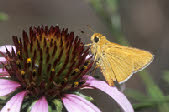The Butterflies of the World Foundation
A Non-





Erynnis horatius, Lexington Wildlife Management Area, Cleveland County, Oklahoma,
11 June 2009 Ref
#: I-


Erynnis horatius, Lexington Wildlife Management Area, Cleveland County, Oklahoma,
11 June 2009 Ref
#: I-
Horace’s Duskywing
Erynnis horatius, Scudder & Burgess, 1870
Subfamily Pyrginae
Tribe Erynnini
Taxonomy
The family Hesperiidae includes all butterflies that are collectively called skippers because of their fast skipping flight. This family is the sole member of the Superfamily Hesperioidea. Whereas, the other five families of butterflies belong to the Superfamily Papilionoidea. So, skippers are considered butterflies, but they have a few traits different than the species of “True” butterflies found in the Superfamily Papilionoidea. Some of these traits include large eyes, short antennae (often with hooked clubs) and stout bodies. Most also have a very rapid flight with a fast, almost blurred, wing beat. There are about 3,500 species of skippers and they’re further divided into seven subfamilies. They occur worldwide with more found in the tropics. Most species are brown or tan, but some tropical members can be quite colorful.

Erynnis horatius, Little River National Wildlife Refuge, McCurtain County, Oklahoma,
28 June 2010 Ref
#: I-
Erynnis horatius, Lexington Wildlife Management Area, Cleveland County, Oklahoma,
11 June 2009 Ref
#: I-

Erynnis horatius, Lexington Wildlife Management Area, Cleveland County, Oklahoma,
2 June 2006 Ref
#: I-

Erynnis horatius, Lexington Wildlife Management Area, Cleveland County, Oklahoma,
11 June 2009 Ref
#: I-

Erynnis horatius, Lexington Wildlife Management Area, Cleveland County, Oklahoma,
11 June 2009 Ref
#: I-

Erynnis horatius, Lexington Wildlife Management Area, Cleveland County, Oklahoma,
11 June 2009 Ref
#: I-

Erynnis horatius, Wichita Mountains National Wildlife Refuge, Comanche County, Oklahoma,
19 July 2010 Ref
#: I-
All photographs, artwork, text and website design are the property of The Butterflies of the World Foundation (unless otherwise stated) and are protected under national and international copyright laws. Photographs, artwork or text on this website may not be reproduced in any way without prior written consent of The Butterflies of the World Foundation.

Blackjack Oak, Quercus marilandica, a common larval food source, Lexington Wildlife
Management Area, Cleveland County, Oklahoma Ref #:
N-

Blackjack Oak, Quercus marilandica, a common larval food source, Lexington Wildlife
Management Area, Cleveland County, Oklahoma Ref #:
N-

Post Oak, Quercus stellata, a common larval food source, Lexington Wildlife Management
Area, Cleveland County, Oklahoma Ref
#: N-

Blackjack Oak, Quercus marilandica, a common larval food source, Lexington Wildlife Management Area, Cleveland County, Oklahoma
Ref #: N-

Post Oak, Quercus stellata, a common larval food source, Lexington Wildlife Management
Area, Cleveland County, Oklahoma Ref
#: N-

Erynnis horatius, McGee Creek Wildlife Management Area, Atoka County, Oklahoma, 12
October 2011 Ref
#: I-
General Information:
Erynnis horatius belongs to the subfamily Pyrginae. This species is found from Massachusetts
west to eastern South Dakota and south through most of the eastern United States
to Florida, the Gulf Coast, and South Texas then south in the west through southeastern
Utah, Colorado, northeastern Arizona and New Mexico. Its preferred habitat includes
open woodlands and edges, clearings, fencerows, wooded swamps, power-
Lifecycle:
The larval food source includes various oaks, Quercus sp. To seek females, males perch at the ends of twigs on hilltops or slopes about one foot above the ground. Mating has been observed around midday. Females deposit eggs singly on new growth of the host. Caterpillars feed on young leaves and rest in leaf nests. Caterpillars of the last brood hibernate.

Erynnis horatius, Lexington Wildlife Management Area, Cleveland County, Oklahoma,
13 March 2006 Ref
#: I-

Blackjack Oak, Quercus marilandica, a common larval food source, Lexington Wildlife
Management Area, Cleveland County, Oklahoma Ref
#: N-

Blackjack Oak, Quercus marilandica, a common larval food source, Lexington Wildlife
Management Area, Cleveland County, Oklahoma Ref #:
N-

Post Oak, Quercus stellata, a common larval food source, Lexington Wildlife Management
Area, Cleveland County, Oklahoma Ref
#: N-

Blackjack Oak, Quercus marilandica, a common larval food source, Lexington Wildlife
Management Area, Cleveland County, Oklahoma Ref #:
N-